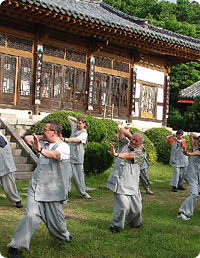SPECIAL INTEREST
Trekking (A) 10 days
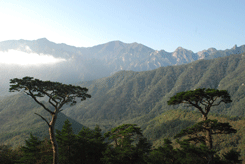
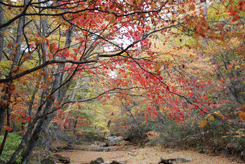
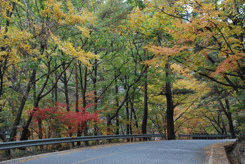
Tour Highlights
- Gyeongbokgung Palace
- National Folk Museum of Korea
- Insadong
- Gwangjang Market
- Chiaksan National Park
- Gosu Cave
- Songnisan National Park
- Beopjusa
- Hahoemaeul Village
- Andong Folk Museum
- Dosanseowon Confucian Acamemy
- Taebaeksan National Park
- Coal Museum
- Naksan Beach
- Seoraksan National Park
- Sokcho Tour
- Unification Observatory
- DMZ Museum
Tour from April through October |
| Tour facts and features | |
| Accommodation | 9 hotel nights in 2 and 4 star twin share accommodation |
| Meals | 9 breakfasts |
| Transport | All transportation by private vehicle |
| Guided | Services of an English speaking guide |
| Group size | Maximum 9 |
| Age range | 18+ |
| Degrees of difficulty | Normal |
Click on the days to access the programs quick
| Days | Visits and Activities | Distance |
| Day 1 | Arrive Seoul | 60km |
| Day 2 | Seoul - Wonju | 130km |
| Day 3 | Wonju - Birobong (1,288m) - Danyang - Cheongpung | 110km |
| Day 4 | Cheongpung - Hwabuk - Munjangdae (1,033m) - Songnisan | 150km |
| Day 5 | Songnisan - Hahoe - Andong | 170km |
| Day 6 | Andong - Taebaeksan (1,567m) - Jeongseon | 180km |
| Day 7 | Jeongseon - Unduryeong - Hangyeryeong - Yangyang - Seoraksan | 210km |
| Day 8 | Seoraksan | |
| Day 9 | Seoraksan - Goseong - Seoul | 310km |
| Day 10 | Departure | 60km |
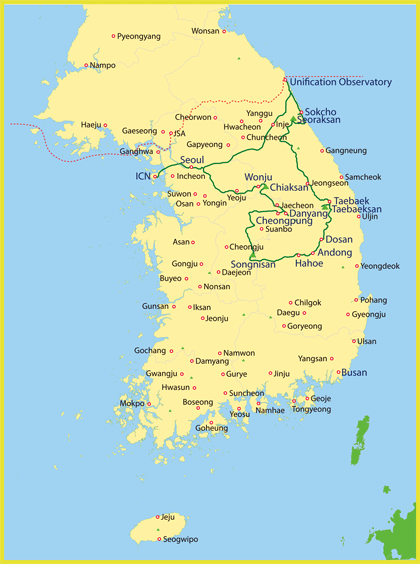 Day 1 Arrive Seoul (- - -)
Day 1 Arrive Seoul (- - -)
60km
Touching down at Incheon International Airport places you in the heart of Korea. After you clear Passport and Customs control, you will be welcomed by the tour guide and then transferred to your hotel.
Day 2 Seoul - Wonju (B) 130km
Your exploration this morning begins with a driving tour of Seoul, featuring sites such as Seoul Plaza, City Hall, Cheonggye Square and pedestrian-friendly Gwanghwamun Plaza that is hemmed in on both sides by rushing traffic and office buildings. The plaza is lined on each side with 365m long streamlets, two centimeters deep and one meter across, the stone bed of the plaza's east side waterway engraved with important events in chronological order from 1392 to 2008.
Step back in time to when life was gracefully slow and discover Gyeongbokgung Palace, a particularly charming spot that represents a colorful and turbulent side of the capital's 500-year history. Depending on timing, you may witness the Royal Guard Changing Ceremony featuring parade, password verification, duty shift and patrolling the gate. Accompanied by a court band with its colorful costumes and royal flags, the ceremony is performed daily basis at 10:00 and 14:00 except Tuesdays, although it is cancelled in case of rain or extremely hot or cold weather.
Your visit to the National Folk Museum of Korea will familiarize you with wealthy culture of this friendly and picturesque nation. It is an excellent facility to illustrate the history of traditional life of the Korean people from the prehistoric age to the Joseon dynasty. The permanent exhibition features life and work, costumes and ornaments, handicrafts and technology, educations, living quarters, dietary life, oriental medicine, performing arts and games, beliefs and rituals, and
socio cultural life.
Insadong, at one time the center of traditional Korean art and antiques, features a mixture of historical and modern atmosphere representing the cultural glimpse of the nation. Clustered along the main street and alleys are lined with street vendors, wooden tea houses, restaurants and numerous galleries and shops dealing in antiques, oriental art supplies, and modern Korean art of all types and styles. Soak in the paintings, upscale artworks, antiques and potteries while you can. Get lucky and you just might meet the artist themselves. It can be plenty of fun walking on the main street, but you venture into the hidden alleys that do spring some unexpected surprises. While here, you may want to buy some souvenirs or simply wander and browse at leisure admiring cultural ambience.
Enjoy a brief visit to Gwangjang market. It is one of few markets retaining traditional Korean atmosphere. Established in 1905, the market today has 5,000 independent shops. On the market's ground level, the floor space is dominated by scores of small snack stalls selling rustic delicacies and cheap treats. Clouds of smoke billow out from the boiling pans, diverse types of pancakes sizzle on hot iron grills and the smell from the eateries filling the air. The roadside vendors hawking everything from food, fruits, vegetables to seafood and an entire upper level dedicated to high quality silk, satin, and linen. Try out some sorts of Korean snacks and see a side of regular Seoul life.
You will also view Dongdaemun which once served as the east gate of Seoul and a block away is DDP of a distinctively neofuturistic design. Characterized by the "powerful, curving forms of elongated structures", it ramains as a major urban development landmark of Seoul. After city exploration, travel to Wonju.
Day 3 Wonju - Birobong (1,288m) - Hwanggol - Danyang - Cheongpung (B) 110km
Today's trekking overview is combination of two routes; Guryeong to Birobong (5.7km) 3 and half hours, and Birobong to Hwanggol (4.1km) 2 and half hours. Hiking starts at Guryong visitor center, where you begin your 6 hour-trekking or 9.8km of both easy and challenging trail over Birobong Peak. First easy stretch of 1 hour and 30 minutes along the valley leads you to the Seryom waterfalls, where trail head divides, one over the rocky trails for 2.7km and the other through the valley for 2.8km leading to the top. From Seryom waterfalls,
the trail gets gradually steep, and about 2 hours climbing. After challenging a very steep path just before Birobong, the highest point of Mt. Chiak, you finally reach the summit, where you will view the spectacular view of the neighboring mountains and valleys. It is not an easy trail for beginners, but it definitely worth trying. Then, descend the path to Hyangnobong Samgeori and finally Hwanggol visitor center. On the way, tour a Ipseoksa temple, home to the seated Buddha statue. Right underneath temple is the Ipsok-dae, a large rectangular stone sitting up on a cliff.
Danyang is a city set in the beautiful surroundings. Enjoy the views of Dodam Sambong rocks representing the typical love triangle of ancient Korea: a husband, his wife and his mistress followed by Gosu cave, known as the most beautiful limestone cave in Korea, formed about 400 million years ago. The cave is filled with intriguing shapes of stalactites and stalagmites formed by large quantity of flowing underground water and the consequent erosions. It is virtually an integrated exhibition hall of all imaginable cave resources. At the nearby Janghoe wharf but on availability, you take a scenic cruise for 40 minutes to Cheongpung, during which you get to see some of the most magnificent rocky mountains and peaks.
Day 4 Cheongpung - Hwabuk - Munjangdae (1,033m) - Songnisan (B) 150km
About 1 hour 40 minute-ride from Cheongpyung is Hwabuk visitor center where you take Munjangdae 2nd Course, a challenging six-hour hiking and climbing (9.7km) up to Munjangdae and finally Beopjusa. Hiking condition is often difficult and dangerous. The first stretch of 2km is relatively easy, and next for 900m is a challenging rocky trails. Signs on the trail warn of falling rocks. On the way, you will pass the spring well and cascade and finally reach the Munjangdae, where a huge flat rock magnificently occupies the top, providing a panoramic view of the park. Descend will be made on the other direction, crossing over the mountain to Beopjuas temple. About 200m from Munjangddae, a steep trail begins. There are iron guardrails, and trails are often challenging until you reach Saesimjeong.
Then the trail turns in dramatically flat, and you will reach the temple in about 45 minutes through the wood. Upon entering Beopjusa dating back to 553, you will certainly stand in awe before the enormous golden Buddha gazing down at the temple and a five-story wooden pagoda, the only one left in Korea. Check out a giant iron pot whose diameter is 2.7 meters that may well had been used to feed 3,000 priests in the early 12th century. A stone carved lantern supported by twin lions standing face to face is a rare example of the magnificent Silla sculptures. A stone water cistern is considered unique for beauty and design. Two stone pillars once held the temple banner pole. An excellent carved relief called Maaebul and worship halls also can be seen.
You cannot miss Four Buddhist Instrument Ceremony. The sounds of each instrument, Brahma bell, Dharma drum, wooden fish and cloud-shaped gong, have a function in saving beings of other realms. Hearing them reverberating through the universe, you will reflect upon the profound symbolism of the instruments. It is a great vow to save or enlighten the creatures in the universe including those on land, in the sea, in the air and in hell.
Day 5 Songnisan - Hahoe - Andong (B) 170km
With leisurely time to pack, travel to Andong, a stronghold of Confucianism. Visit UNESCO World Heritage Site, Hahoemaeul from the 15th century. It is the best preserved traditional village portraying and spanning the life of the Joseon Dynasty (1392-1910) and some 480 Korean traditional houses, both large and small, are still fully functioning. As you take a walk in the narrow alleys, enjoy the rustic and old charm of this unique village. You cannot possibly miss a 600-years old zelkova tree, the home to the village spirit. At the tree's base is where residents still make their wishes. The village is also known for traditional festival, Hahoe Mask Dance which gave common people the opportunity to mock those in authority, and in particular the Byeolsingut, a shaman ritual exorcising evil spirits, dating back to the Goryeo dynasty (918-1392).
Stop off at a traditional paper-making workshop to get a glimpse into the world of hand-made paper manufacturing - a painstaking process which hasn't changed much from ancient times. Start with bark from the mulberry tree, then separate the bark from the fibers that would eventually be transformed into paper. After straining the pulp, adding some glue, drying the paper, and cutting or coloring according to need, they get a quality paper that is unique to Andong.
Tour also includes Andong Folk Museum offering in-depth information of traditional life and illustrating traditional Confucian culture. The museum exhibits a variety of legacies relating mainly to four cardinal ceremonies, coming of an age, wedding, funeral, ancestral memorial service, as well as dozens of pieces of pottery, utensils, clothing, farming tools and traditional folk games in small models.
Day 6 Andong - Dosan - Taebaeksan (1,567m) - Jeongseon (B) 180km
The day is a bit heavy with more visits and hiking. Dosan Seowon is a Confucian-shrine academy which was established in 1574 in memory of Yi Hwang (1501-1570) who introduced Neo-Confucianism into Korea. The facility is composed of 16 buildings most of which were built in a simple and concise style. About hundreds of Seowon were functioning by the early 1800s, but then most of them were destroyed around 1870 by the ourt order. Dosan Seowon is among some of the few survived academies. Although the educational function of the facility has long since ceased, but you can feel Confucian ideology and value that has deeply influenced the lives of Koreans in all aspects.
Yuilsa Course of 7.5km for about 4 hours is planned. Located at the fork of Baekdudaegan Mountain Range, which starts its range from Baekdusan into the south, heading to Jirisan, Taebaeksan features a great forest setting. It also creates various and outstanding ecological landscapes including wild flowers, yew habitat and Alpine plants.
At the trail end is Taebaek coal museum.Taebaek is a highland town once boomed with coal mining until the early 1980s. The museum showcases Korea's coal mining with well over 8,000 items including rocks such as silver, ore, fossils, and mining equipments and documents. You will also explore a mine simulation modeled closely after real mine showing how the mining work was like.
Taebaek boasts of two river sources. Hwangji pond from which 5,000 tons of water flows daily is the source of the Nakdong River and Geomryongso is that of Han River. you will have time to see Hwangji pond. The pond is a joint of underground water flow through the valleys of the mountains surrounding Taebaek.
Day 7 Jeongseon - Unduryeong - Hangyeryeong - Yangyang - Seoraksan (B) 210km
Today is relatively relaxing. With time for a short stop at Unduryeong pass, drive the beautiful Misan Valley where clear Naerincheon water runs along for about 57km, admiring the pure look of upstream of Naerincheon. The view shows unpolluted, clean, and blue water ruffling through the rocks. You will also see the lonesome rural villages with their small swath of farms. In addition, mushrooms, honey bees, the sap from Acer mono trees and wild vegetables are some of the local specialties. Drive continues on Hangyeryeong pass down to Yangyang. Your journey is such a stark contrast from remote valley to the city. Spend the afternoon at the Naksan beach.
A short drive from the beach is Seoraksan national park.
Seoraksan features rugged peaks, fantastic cliffs, numerous waterfalls, unique rock formations, and scenic valleys altogether make this park and surrounding area some of the best scenery on the Korean peninsula, and give this area an unparalleled popularity around the year. The spring brings full of blooms and the summer creates lush green vegetation and crystal clear streams tumble over the cataracts. Fall changes foliage into brilliant colors and even in the winter, the snow blankets the hushed landscape, bringing serenity and a quiet beauty. You can definitely find lots of outdoor activities to make it worth while for an extended stay.
Day 8 Seoraksan (B)
The word of the day is hiking of varying lengths and difficulty. Only a small walk from the park entrance, you will marvel at a large bronze statues, Unification Buddha, symbolizing Korean people's hope for reunification of the country. A little further on is Sinheungsa temple where Cheonbuldong valley and Ulsanbawi trails begin.
Cheonbuldong valley Trail
It is the most impressive valley in the park, leading to Biseondae, Yangpok waterfalls and finally the peak of Seoraksan (1,708m). One hears many legends of the heavenly nymphs who come down to play at Biseondae while taking a bathe in the placid pools of the valleys that are hidden from the human eyes. Near Biseondae rises Janggunbong majestically and among the crags of it is Geumgang cave with a tiny temple inside. You will head up a very steep incline for 600m from the gentle slope of the trail, and you can scale only by carefully ascending the long, steep, metal stairs bolted onto the sheer cliff face. The hike, although hard, comes with a stunning view of numerous cliffy peaks and mountain valley. From Biseondae, another 3.5km to Yangpok Falls, so spacious yet everywhere you looked you are surrounded by giant mountain peaks.
Ulsanbawi Trail
About an hour and half into the walk from the park entrance is Gyejoam hermitage. Located at the base of Ulsanbawi, and the point at which the trail takes a sharp rise upwards. In front of the hermitage on a spacious stone slab is a huge spherical rock called Heundeulbawi. This rock is so perfectly balanced that it can be shaken with some effort, but nobody gets further than waggling it. Your adventure begins by climbing a massive steep staircase that winds its way up the side of the cliff that angle up Ulsanbawi, a 2.8km-long ridge of naked, gray stone peaks jutting 873m into the sky.
Biryong waterfall Trail
The trail is relatively easy for anyone to enjoy and you will view Biryeong waterfalls at the trail end. About 400m further above the falls, you will be amazed at Towangseong waterfalls cascading down a 320-meter cliff.
Cable Car
There is a cable car that picks you up at the valley floor to the Gwongeumseong. The peak is surrounded by cavernous drop-off cliffs, cloaked in more towering rocky summits. Definitely, you stand in awe on the top: sweeping panoramic views of the park around you, the Pacific Ocean, and the small beachside town of Sokcho. Be careful as always as there is not much room to move about and people constantly going up and down and moving around.
Among the recommendable trails from Sogongwon or park entrance (230m above sea level) are as follow and the given times are based on round trip starting and ending at Sogongwon in a relaxed pace.
1. Biryong Falls (310m) + Towangseong Falls observatory (5.6km): 3 hours 30 minutes
- Moderate and Strenuous
2. Biseondae (334m) (6km): 2 hours 30 minutes - Moderate
3. Biseondae + Geumgang cave (495m) (7.2km): 4 hours - Moderate and Strenuous
4. Biseondae + Yangpok (715m) (13.2km): 7 hours - Moderate
5. Heundeulbawi (510m) (6.6km): 3 hours - Moderate
6. Heundeulbawi + Ulsanbawi (873m) (7.6km): 5 hours 30 minutes - Moderate and Strenuous
7. Gwongeumseong (800m) Cable car (3.4km): 1 hour (roughly four minutes each up and down)
- Moderate
Sokcho has so much more to offer than just mountains. Daepohang becomes a great attraction when this small alley lit up. You will see a wide variety of fresh seafood harvested from the nearby sea and a number of small restaurants serving sliced raw fish. You will find something to enjoy, from simply feeling the ambiance of this small fishing port to taking picture. And in downtown, there is a colorful market selling fishes, fruits, vegetables, grains and daily necessities, and a little further down is a North Korean refugee village that can be accessible by a hand-pulled boat.
Day 9 Seoraksan - Goseong - Seoul (B) 310km
Travel to the most northern tip of the east coast. Less convenient to get to, the route offers much more pleasant countryside scenery and remote tranquility. Unification Observatory was established in 1983 to console pains of division, nostalgia and inscribe unification will. With the entry permit and sign to place in the vehicle window ready, you continue towards the north, driving past lots of tank traps sat on either side of the road, all a strange and eerie reminder of the tensions that exist between the two Koreas and the stark reality of the divided country. The big blocks are designed to topple onto the road and create a road block to prevent an advance of the North's tanks and artillery vehicles into the South. Once there, you will get a glimpse of the much talked about border dividing the two Koreas and see the road and train track stretched side by side ahead across the North Korea, and soldiers patrolling the beach as well as some nearby islands.
Visit DMZ Museum (Closed on Mondays) offering a surreal experience. In a hope of bringing peace to the country from the painful past, the museum presents a South Korean side of conflict with the North, understanding the historical significance of the DMZ and embracing everything about the latest efforts made to transform the DMZ from a political scars to a symbol of peace and ecology.
Day 10 Departure (B) 60km
After this wonderful trip exploring Korea and with time to reflect on your surprise in your experience, you will return to the airport in time for your flight. By boarding, you are already high above Incheon heading for home.





